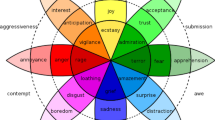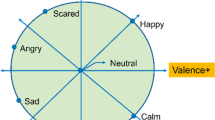Abstract
In order to enable personalized natural interaction in service robots, artificial emotion is needed which helps robots to appear as individuals. In the emotion modeling theory of emotional Markov chain model (eMCM) for spontaneous transfer and emotional hidden Markov model (eHMM) for stimulated transfer, there are three problems: 1) Emotion distinguishing problem: whether adjusting parameters of the model have any effects on individual emotions; 2) How much effect the change makes; 3) The problem of different initial emotional states leading to different resultant emotions from a given stimuli. To solve these problems, a research method of individual emotional difference is proposed based on metric multidimensional scaling theory. Using a dissimilarity matrix, a scalar product matrix is calculated. Subsequently, an individual attribute reconstructing matrix can be obtained by principal component factor analysis. This can display individual emotion difference with low dimension. In addition, some mathematical proofs are carried out to explain experimental results. Synthesizing the results and proofs, corresponding conclusions are obtained. This new method provides guidance for the adjustment of parameters of emotion models in artificial emotion theory.
Similar content being viewed by others
References
Wang G J, Wang Z L, Yang G L, Wang Y J, Chen F J. Survey of artificial emotion. Application Research of Computers, 2006, 23(11): 7–11 (in Chinese)
Wang Z L. Artificial psychology-a most accessible science research to human brain. Journal of University of Science and Technology Beijing, 2000, 22(5): 478–481 (in Chinese)
Ortony A, Clore G L, Collins A. The Cognitive Structure of Emotions. Cambridge: Cambridge University Press, 1988
Breazeal C. Designing Sociable Robots. Cambridge: MIT Press, 2002
Botelho L M, Coelho H. Machinery for artificial emotions. Cybernetics and Systems, 2001, 32(5): 465–506
Miwa H, Itoh K, Ito D, Takanobu H, Takanishi A. Introduction of the need model for humanoid robots to generate active behavior. In: Proceedings of 2003 IEEE/RSJ International Conference on Intelligent Robots and Systems. 2003, 1400–1406
Wang H, Jie B, Xie L. Emotion model based on theory of artificial psychology and numerical simulation. Computer Applications, 2004, 22(S1): 368–370 (in Chinese)
Teng S D. Research on artificial psychology model applied in personal robot. Dissertation for the Doctoral Degree. Beijing: University of Science and Technology Beijing, 2006 (in Chinese)
Wang F, Wang Z L, Zhao J C, Chen N. Affection mathematics model based on the processing of stochastic events. Control & Automation, 2005, 21(3): 101–102 (in Chinese)
Cheng N, Fan Y M, Liu J W, Wang Z L. Application of basic emotions theory in construction of artificial psychology model. Computer Engineering, 2005, 31(22): 175–177 (in Chinese)
Vathy-Fogarassy A, Abonyi J. Local and global mappings of topology representing networks. Information Sciences, 2009, 179(21): 3791–3803
Carter K M, Raich R, Finn W G, Hero III A O. FINE: fisher information nonparametric embedding. IEEE Transactions on Pattern Analysis and Machine Intelligence, 2009, 31(11): 2093–2098
Miclaus K, Wolfinger R, Czika W. SNP selection and multidimensional scaling to quantify population structure. Genetic Epidemiology, 2009, 33(6): 488–496
Lespinats S, Fertil B, Villemain P, Hérault J. RankVisu: mapping from the neighborhood network. Neurocomputing, 2009, 72(13–15): 2964–2978
Pei Z M, Deng Z D, Xu S, Xu X. Anchor-free localization method for mobile targets in coal mine wireless sensor networks. Sensors, 2009, 9(4): 2836–2850 (in Chinese)
Brouwer R K. A method of relational fuzzy clustering based on producing feature vectors using FastMap. Information Sciences, 2009, 179(20): 3561–3582
Chen Z X, Wan Q, Wei H W, Yang W L. A novel subspace approach for hyperbolic mobile location. Chinese Journal of Electronics, 2009, 18(3): 569–573 (in Chinese)
Ventura R, Pinto-Ferreira C. Responding efficiently to relevant stimuli using an emotion-based agent architecture. Neurocomputing, 2009, 72(13–15): 2923–2930
Shao Z F. Psychological Statistics. Beijing: China Light Industry Press, 2009 (in Chinese)
Zhang J T, Sun C Y, Wang S J. Applied Statistics. Beijing: Tsinghua University Press, 2010 (in Chinese)
Davison M L. Multidimensional Scaling. New York: Wiley, 1983, 61–78
Author information
Authors and Affiliations
Corresponding author
Rights and permissions
About this article
Cite this article
Wang, W., Wang, Z., Zheng, S. et al. Individual difference of artificial emotion applied to a service robot. Front. Comput. Sci. China 5, 216–226 (2011). https://doi.org/10.1007/s11704-010-0145-9
Received:
Accepted:
Published:
Issue Date:
DOI: https://doi.org/10.1007/s11704-010-0145-9




